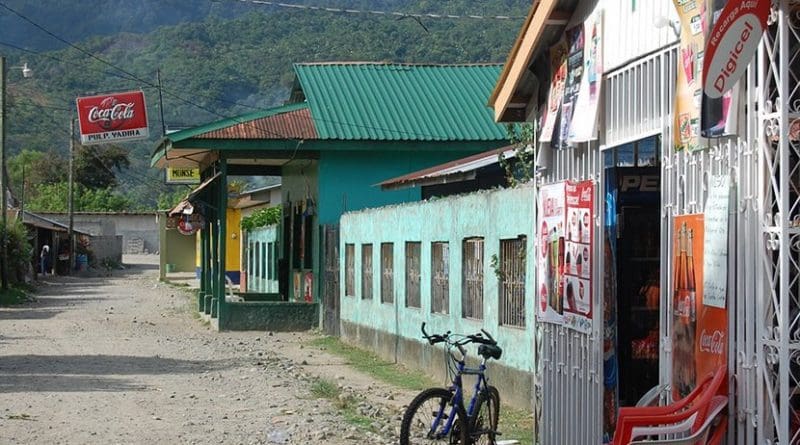Crime, Not Money, Drives Migration From El Salvador And Honduras
An analysis of data directed by Jonathan Hiskey, associate professor of political science, and his co-authors shows that being a victim of crime is a powerful motivation for migrants to come to the United States, despite understanding the risks of the journey and challenges of the U.S. immigration system.
The findings, Hiskey says, suggest that current migration deterrence policies, which mainly target economic migrants, are ineffective against migrants fleeing violence. The research will be published in the forthcoming issue of Latin American Research Review. Political scientists Mary Fran Malone of the University of New Hampshire and Vanderbilt Ph.D. graduates Abby Córdova of the University of Kentucky and Diana Orcés of the American Immigration Council also contributed to the research.
In 2014, the United States saw a dramatic spike in migration from Central America, creating a humanitarian crisis along the U.S.-Mexico border. In response, the Obama administration implemented a number of efforts to detain and deport the newcomers, as well as launching “know before you go”-type multimedia campaigns throughout Central America to deter potential migrants by warning them about the dangers of the journey north and the high risk of detention and deportation upon arrival.
However, these efforts did little to stem that migration.
Since several of these nations have exceptionally high crime rates, and there is anecdotal evidence that crime is a heavy driver of migration from these countries, the researchers sought to measure the phenomenon empirically. To do so, they analyzed data from Vanderbilt’s Latin American Public Opinion Project’s 2014 AmericasBarometer survey, which included questions about respondents’ personal experience with crime and whether they intended to migrate to the U.S. in the next three years. (The AmericasBarometer survey, which is conducted entirely in person by fieldworkers, is considered to be the gold standard for public opinion research, making the data highly reliable.)
Crime is a powerful migration motivator
“We found that one of the most powerful predictors of migration is if the person has been victimized by crime in the previous 12 months, and an even more powerful predictor is if that person has been victimized multiple times by crime,” Hiskey said.
Of those from El Salvador expressing an intent to migrate who said they had been the victim of a crime in the previous year, 35 percent had been victimized once, and 44 percent had been victimized multiple times. Of those from Honduras, 39 percent had been victimized once, while 56 percent had been victimized more than once.
In El Salvador and Honduras, Hiskey said, the violence is often a widespread daily occurrence, where families are routinely extorted, and where children are recruited by force into gangs or to participate into violent initiation rituals. “It’s a situation of constantly being exposed to violence and crime, in addition to a government that is either unwilling or unable to do anything to improve the situation,” Hiskey explained. “Once individuals have lived through this for several years, they reach a point where they just say, simply, ‘I don’t care what lies in front of me, I have to leave, I have to get my kids out.'”
While Guatemala also has a high crime rate, it didn’t appear to be influencing the immigration decision nearly as strongly. This was likely due to the difference in the type and distribution of crime in that country, though it is a question the authors plan to explore more thoroughly in future research.
Migrants know the risks
They then tested the reach of the deterrence campaign with a special survey conducted by LAPOP in Honduras and found that people were overwhelmingly aware of the U.S. warnings. Nearly nine in ten understood that crossing the U.S. border was more difficult, while 8 in 10 understood it to be less safe and that deportations were increased. Two-thirds also believed that migrants were being treated worse in the U.S. than they used to be.
Hiskey said this suggests that migrants who have been repeatedly victimized are likely so desperate to leave that they are willing to take their chances in the U.S., no matter how hard it seems. These are not the kind of migrants who are likely to respond to measures designed to stem economic migrants, Hiskey said. “What we see is a very different demographic profile of the individuals arriving now. The U.S. policy approach to unauthorized migration at the Southwest border, in my mind, has to change fundamentally to match who’s arriving.”
Though Hiskey said their findings may not be all that surprising, given how violent these three Central American countries are known to be and given the stories that migrants have been telling, it’s important to be able to attach real numbers to the problem in order to solve it. “I think what our survey-based research does, through the work of the Latin American Public Opinion Project, is provide empirical, statistical support for the anecdotal and qualitative evidence that’s already out there.”

